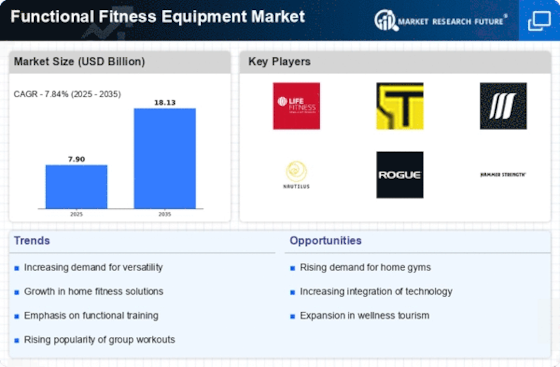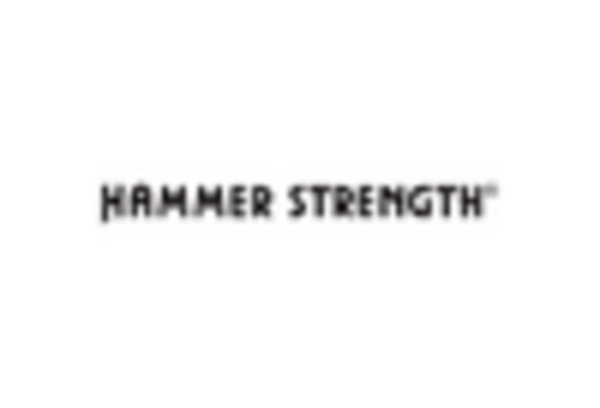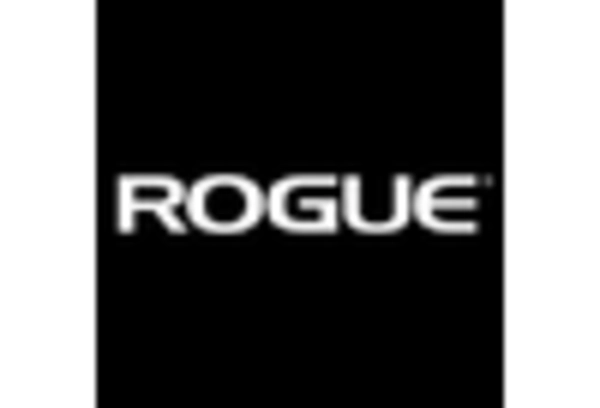The Functional Fitness Equipment Market is currently characterized by a dynamic competitive landscape, driven by increasing consumer demand for versatile and effective workout solutions. Key players such as Life Fitness (US), Technogym (IT), and Rogue Fitness (US) are at the forefront, each adopting distinct strategies to enhance their market presence. Life Fitness (US) focuses on innovation and product diversification, aiming to cater to both commercial and home fitness segments. Technogym (IT) emphasizes digital transformation, integrating technology into their equipment to offer personalized training experiences. Meanwhile, Rogue Fitness (US) leverages its strong brand loyalty and community engagement to expand its market share, particularly in the strength training segment. Collectively, these strategies contribute to a competitive environment that is increasingly centered around innovation and customer-centric solutions.
In terms of business tactics, companies are increasingly localizing manufacturing and optimizing supply chains to enhance efficiency and reduce costs. The market structure appears moderately fragmented, with several key players holding substantial shares while numerous smaller companies also compete. This fragmentation allows for a diverse range of products and services, catering to various consumer preferences and fitness trends. The collective influence of these key players shapes the market dynamics, as they continuously adapt to changing consumer demands and technological advancements.
In August 2025, Technogym (IT) announced the launch of its new digital platform, which integrates AI-driven personal training programs with its existing equipment line. This strategic move is significant as it positions Technogym at the intersection of fitness and technology, potentially attracting a tech-savvy consumer base looking for personalized fitness solutions. The integration of AI not only enhances user experience but also aligns with the growing trend of digital fitness solutions.
In September 2025, Rogue Fitness (US) expanded its product line to include eco-friendly fitness equipment, responding to the increasing consumer demand for sustainable products. This initiative is crucial as it reflects a broader industry trend towards sustainability, allowing Rogue Fitness to differentiate itself in a crowded market. By prioritizing environmentally friendly materials and manufacturing processes, the company may enhance its brand reputation and appeal to environmentally conscious consumers.
In October 2025, Life Fitness (US) entered into a strategic partnership with a leading health and wellness app to offer integrated fitness solutions. This collaboration is indicative of the current trend towards holistic health approaches, where fitness equipment is not just a standalone product but part of a broader lifestyle ecosystem. Such partnerships may enhance customer engagement and retention, as users benefit from a seamless integration of fitness equipment and digital health resources.
As of October 2025, the competitive trends in the Functional Fitness Equipment Market are increasingly defined by digitalization, sustainability, and the integration of advanced technologies such as AI. Strategic alliances are becoming more prevalent, shaping the landscape as companies seek to enhance their offerings and customer experiences. Looking ahead, competitive differentiation is likely to evolve from traditional price-based competition to a focus on innovation, technological integration, and supply chain reliability, as companies strive to meet the sophisticated demands of modern consumers.

















Leave a Comment